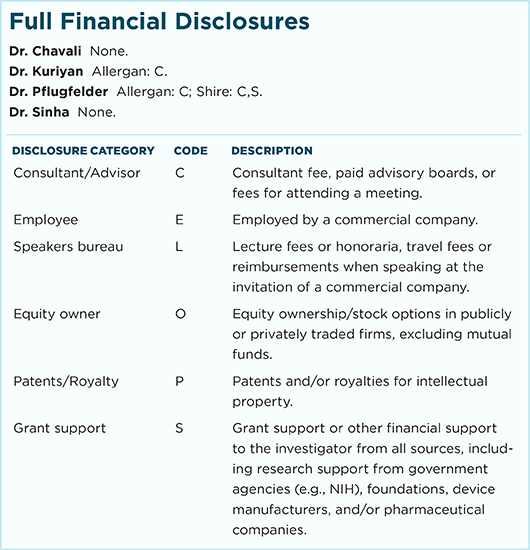Download PDF
Seeking to prevent severe vision loss associated with dry age-related macular degeneration (AMD), 3 women in their 70s and 80s underwent experimental autologous stem cell treatments at a Florida for-profit stem cell clinic in the summer of 2015. There they received bilateral intravitreal injections of adipose tissue–derived stem cells.1
Devastating consequences. But instead of preventing vision loss, the procedures caused blinding complications in all 3 patients, including ocular hypertension, hemorrhage, lens dislocation, and retinal detachment. Within days of the procedure, they sought the help of ophthalmologists not connected with the stem cell clinic.
Before the experimental procedure, all 3 patients could drive. “The better-seeing eyes of the patients ranged from 20/30 to 20/50,” said Ajay E. Kuriyan, MD, at the University of Rochester Medical Center in Rochester, N.Y. “One year after treatment, visual acuity ranged from 20/200 to no light perception.”
Potential causes. “We suspect that cell preparation enzymes may have led to profound zonular weakness, experienced by all 3 patients,” said Dr. Kuriyan. In 1 patient, who was phakic at the time, the zonules had become so weak that her lenses moved forward, closing off the trabecular meshwork. The subsequent increase in intraocular pressure caused severe pain as well as vision loss.
“We took out both her lenses and cleared material that had been injected into the eye,” said Dr. Kuriyan. “She had a retinal detachment in one eye, which we reattached, but later developed a lot of scar tissue and the retina detached once again.”
All of the other patients’ eyes also developed severe retinal detachments and proliferative vitreoretinopathy. The authors hypothesize that the injected mesenchymal cells—known for their contractile property—stayed on the surface of the retina and contracted, leading to retinal detachment and scar tissue formation.
Time to educate patients. It’s critical to inform patients about the risks of such stem cell clinics, said Dr. Kuriyan, who added that he was dismayed to discover the size of the stem cell clinic industry. It is difficult to confirm the number of these clinics, but 1 study found 187 unique websites offering stem cell procedures at 215 clinics in the United States alone. He and his colleagues hope to create a registry to collect information about similar emerging cases, some of which have surfaced following publication of their paper.
Clinicians can help, said Dr. Kuriyan, by alerting patients to red flags, by strongly suggesting patients steer clear of clinics that offer stem cell therapies alone, experimentally treat both eyes on the same day, or require patients to make out-of-pocket payments for a “clinical trial”—none of which are standard practices. Also, they can inform their patients that ClinicalTrials.gov is a registry, not a U.S. government endorsement of the study.
Issue of oversight. Parke et al. noted “these clinics have been operating largely without regulation because their stem-cell products have been self-identified as falling into a category not subject to regulatory oversight.”2
The FDA has released draft guidance statements, which make clear that autologous transplants should be under their jurisdiction and regulation, said Dr. Kuriyan. However, more guidance is on the way: The FDA is reportedly finalizing 4 new guidelines to clarify how stem cells may be used.3
—Annie Stuart
___________________________
1 Kuriyan AE et al. N Engl J Med. 2017;376(11):1047-1053.
2 Parke DW II et al. Ophthalmology. 2016;123(10):S62-S63.
3 aao.org/editors-choice/unapproved-stem-cell-treatment-blinds-3. March 17, 2017.
___________________________
Relevant financial disclosures—Dr. Kuriyan: None.
For full disclosures and disclosure key, see below.

More from this month’s News in Review